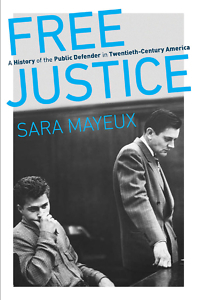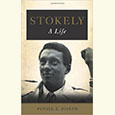Courting Justice
Vanderbilt law scholar Sara Mayeux chronicles the role of the public defender in American history
In 1964, journalist Anthony Lewis published Gideon’s Trumpet, which chronicled the Supreme Court case that guaranteed legal representation to any accused criminal. The popular book told a triumphant tale about enlightened lawyers and judges, promoting a liberal ideal. In Free Justice, Vanderbilt University legal historian Sara Mayeux complicates that narrative. Her rich, detailed study spans the 20th century, examining debates about the necessity and role of public defenders. Those debates shed light on our competing ideas about American democracy.
 Mayeux earned a law degree and Ph.D. in history from Stanford University and joined the Vanderbilt Law faculty in 2016. She answered questions via email from Chapter 16:
Mayeux earned a law degree and Ph.D. in history from Stanford University and joined the Vanderbilt Law faculty in 2016. She answered questions via email from Chapter 16:
Chapter 16: You define the book’s central question as “how the public defender became a national ideal.” Why is this story important? What can it tell us about American political identity?
Sara Mayeux: It may sound odd to describe the public defender as a national ideal. I imagine that if you asked people on the street to list some national ideals, they would speak more generally about freedom, equality, democracy. What I found interesting is that, in the 20th century, lawyers came to describe public defenders as embodying those lofty principles. But they didn’t always. In fact, earlier in the 20th century, many lawyers wrote off the public defender as a fringe reform proposal.
Why did their views change? In one sense, criminal defendants’ rights have always been intertwined with broader political questions in the United States; the Bill of Rights is largely about criminal procedure. But in the 20th century, lawyers began to understand and talk about those rights in new ways. We can learn a lot from this history, not just about criminal law, but about the power of the legal profession in defining American understanding of justice and equality, and the limitations of American political culture when it comes to confronting poverty and economic inequality.
Chapter 16: You are trained as both a lawyer and a historian. How do those skills intersect? How do they diverge? How have they shaped your approach to writing this book?
Mayeux: The day-to-day work of lawyers and historians is similar in many ways. They look at evidence, figure out what they think the evidence proves, and try to arrange the evidence in a way that will persuade others. But lawyers tend to start with a question they’re trying to answer, usually because there’s some short-term, real-world problem that depends on the answer. Does this statute apply to my client? How should the court interpret this clause of the Constitution?
Most of the time, historical research is more open-ended. A historian might go into the archives with one question but quickly realize that people in the past were actually worried about a totally different question. The book is about lawyers, but I approached writing it more like a historian. My goal was to explore how lawyers talked about these issues in the past, which was often quite different from how we talk about them today.
 Chapter 16: Free Justice begins with Mayer Goldman, an early 20th-century advocate for public defenders in criminal cases. Why did few states have public defenders? What was Goldman’s Progressive Era vision for the legal profession?
Chapter 16: Free Justice begins with Mayer Goldman, an early 20th-century advocate for public defenders in criminal cases. Why did few states have public defenders? What was Goldman’s Progressive Era vision for the legal profession?
Mayeux: Traditionally, courts had ad hoc ways of providing defendants with counsel, relying on lawyers in private practice to handle the occasional case pro bono. Lawyers, especially in small towns, weren’t as specialized as they are today. In a big murder trial, the judge might appoint a prominent local lawyer. By the 20th century, these traditions were breaking down. Legal practice was highly specialized, and a lot of lawyers didn’t want to handle criminal cases. Meanwhile, there were stories of unscrupulous lawyers offering to represent desperate defendants, then extorting their families for payment. Urban courts needed to develop new, modern practices to replace these old-fashioned, small-town norms.
Mayer Goldman proposed that every city should establish “public defenders.” By that term, he meant something very specific: upstanding, salaried, government-employed defense lawyers. But Goldman’s vision went beyond the public defenders we have today. He argued that every defendant should have a public defender. So, in (more) contemporary terms, the ordinary teenager charged with auto theft would have a public defender, and O.J. Simpson or John Gotti should be required to submit to representation by the very same public defender. Only then, in his view, would the courts truly be equal. That idea never got far. But Goldman’s writings show how far some Progressive Era reformers were willing to go in reimagining inherited institutions.
Chapter 16: The call for public defenders accelerated in the 1950s, at the height of the Cold War. This is surprising! I would have guessed that anti-communists would quash the idea as “creeping socialism.” Why, instead, did the momentum lead toward the 1963 Supreme Court case Gideon v. Wainwright?
Mayeux: The timing appears paradoxical at first glance. Of course, during the 1960s there would develop more political momentum for anti-poverty efforts, but lawyers’ views were already shifting earlier, in the 1950s. That was precisely because they didn’t view the public defender as part of any broader expansion of government aid to the poor. Rather, it was about protecting individual rights. So, you might say they emphasized the defender part of the equation, while skipping over the public part of the equation. During the Cold War, lawyers celebrated American-style jury trials for embodying “democratic justice,” in contrast to Soviet-style show trials. Along those lines, Gideon doesn’t talk about the institution of the public defender per se; it celebrates the constitutional right to counsel in more general terms, connecting adversarial trials with American national identity.
Chapter 16: What was the real impact of Gideon v. Wainwright? What has it meant (and not meant) for the expansion of liberal democracy?
Mayeux: Clearly, Gideon has not proven transformative in the ways that advocates hoped. Criminal punishment remains extremely unequal — in some ways more unequal than at the time of Gideon. The whole apparatus of policing, courts, and prisons is now much larger, and too many defendants still don’t get meaningful advocacy. However, Gideon did spur significant institutional change in a lot of the country. The decision inspired efforts to establish and expand public defenders. That’s how we ended up with what we have today, which is a national infrastructure of public defenders around the country — albeit a very fragmented, localized, patchwork infrastructure.
Chapter 16: How can Free Justice help us understand contemporary debates over the role of the law in the struggle for racial justice?
Mayeux: Historically, many lawyers distinguished between civil rights cases and ordinary, run-of-the-mill criminal cases, so they didn’t necessarily view public defenders — while important — as central to the struggle for racial justice. That has changed. Many public defenders today would argue that even the most seemingly routine, day-to-day business of the criminal courts implicates deep questions of racial justice. I don’t think history can tell us what to do about these issues going forward, but it can help provide context for why we ended up with the institutions we have today. There is no preordained reason our institutions must look like they do. People in the past made decisions within particular contexts, and there’s no reason we can’t revisit those decisions.

Aram Goudsouzian is the Bizot Family Professor of History at the University of Memphis. His most recent book is The Men and the Moment: The Election of 1968 and the Rise of Partisan Politics in America.





